Social interaction features in multiplayer fantasy adventure games significantly enhance player engagement and retention. Key elements include cooperative gameplay, player trading systems, guilds, in-game communication tools, and social events. These features vary across platforms, influencing user experience and community dynamics. Emerging trends like virtual reality and AI-driven interactions promise to further enrich social experiences in gaming.
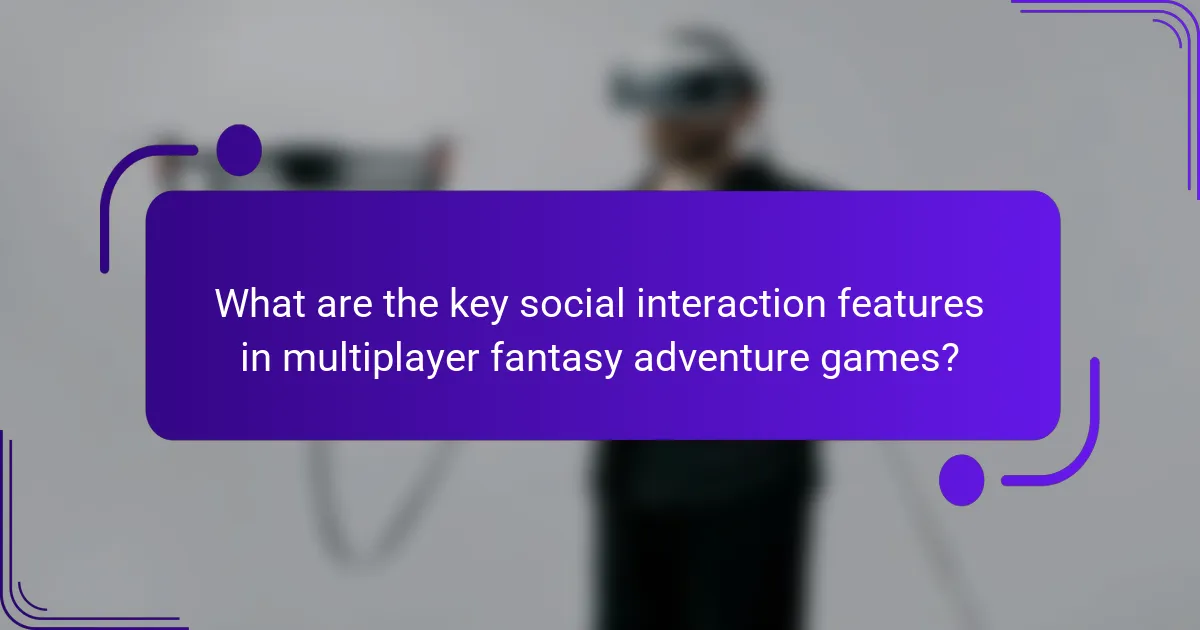
What are the key social interaction features in multiplayer fantasy adventure games?
Multiplayer fantasy adventure games feature several key social interaction elements. These include cooperative gameplay, player trading systems, guilds or clans, in-game communication tools, and social events.
Cooperative gameplay allows players to team up for quests, enhancing teamwork and strategy. Player trading systems facilitate the exchange of items, fostering community engagement. Guilds or clans provide a structured way for players to form groups, share resources, and build camaraderie. In-game communication tools, such as chat and voice options, enable real-time interaction. Social events, like tournaments or festivals, create opportunities for players to gather and celebrate achievements together.
How do communication tools enhance player engagement?
Communication tools enhance player engagement by facilitating real-time interactions and collaboration. These features promote teamwork, social bonding, and shared experiences in multiplayer fantasy adventure games. Players can strategize together, share resources, and build friendships, which deepens their investment in the game. Enhanced communication fosters a sense of community, making players more likely to return and participate actively.
What role do in-game events play in fostering social connections?
In-game events significantly enhance social connections among players in multiplayer fantasy adventure games. These events create shared experiences, fostering teamwork and collaboration. Players engage in challenges, quests, or competitions that require cooperation, promoting communication and camaraderie.
Additionally, in-game events often feature unique rewards and limited-time content, encouraging players to participate together. This sense of urgency can strengthen bonds as players strategize and support each other to achieve common goals.
Social interaction features, such as chat systems and guilds, further facilitate these connections during events. Players can form lasting friendships, share tips, and celebrate achievements, contributing to a vibrant gaming community.
Overall, in-game events serve as crucial touchpoints for social interaction, making multiplayer fantasy adventure games more engaging and community-oriented.
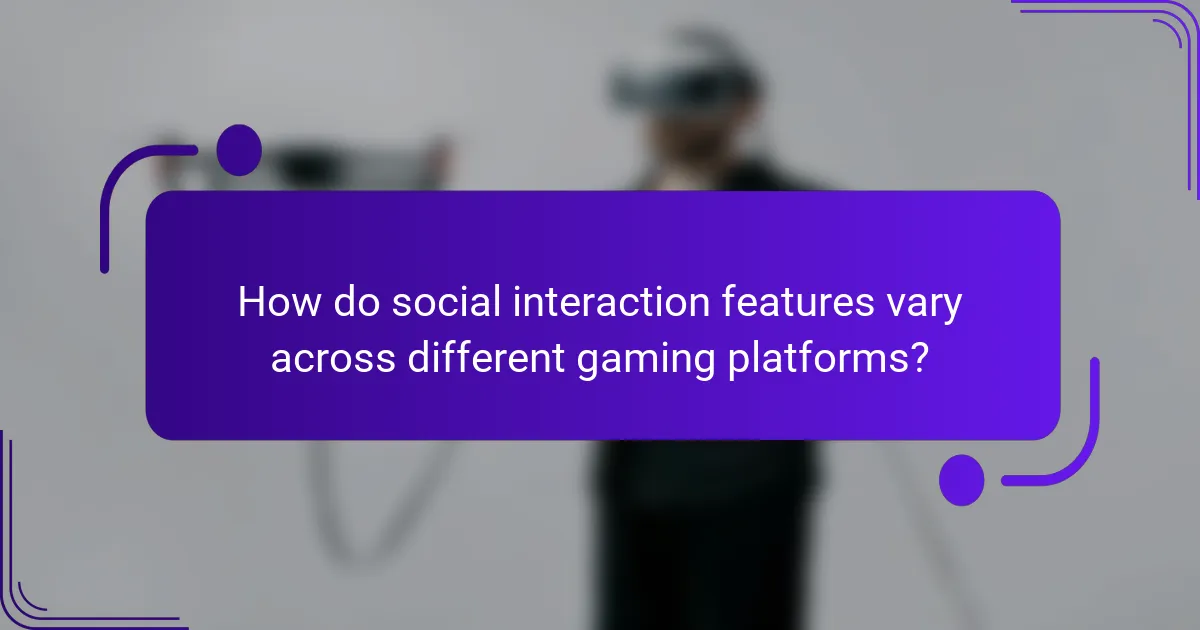
How do social interaction features vary across different gaming platforms?
Social interaction features in multiplayer fantasy adventure games vary significantly across platforms. Console gaming often emphasizes voice chat and party systems, while PC platforms provide robust text chat and modding communities. Mobile games typically utilize simplified social features like friend lists and basic messaging.
Cross-platform capabilities enhance social interactions, allowing players to connect regardless of their device. Unique attributes, such as integrated social media sharing on mobile, differ from the immersive guild systems found in PC games. These variations cater to each platform’s user experience and community engagement preferences.
What unique attributes do console-based multiplayer games offer?
Console-based multiplayer games offer unique social interaction features that enhance player engagement. These games facilitate real-time communication through voice chat, allowing players to strategize and build camaraderie. Cooperative gameplay encourages teamwork, fostering connections among players. Unique attributes include customizable avatars that represent individual identities, enhancing personal expression. Additionally, in-game events and community challenges create shared experiences that strengthen social bonds.
How do PC games facilitate social interactions differently?
Multiplayer fantasy adventure games facilitate social interactions through cooperative gameplay, guild systems, and in-game communication tools. Players engage in quests together, forming bonds over shared experiences. Guilds foster community by allowing players to collaborate and share resources. Communication tools enable real-time interaction, enhancing teamwork and friendship. These features create a unique social environment, differing from traditional gaming interactions.
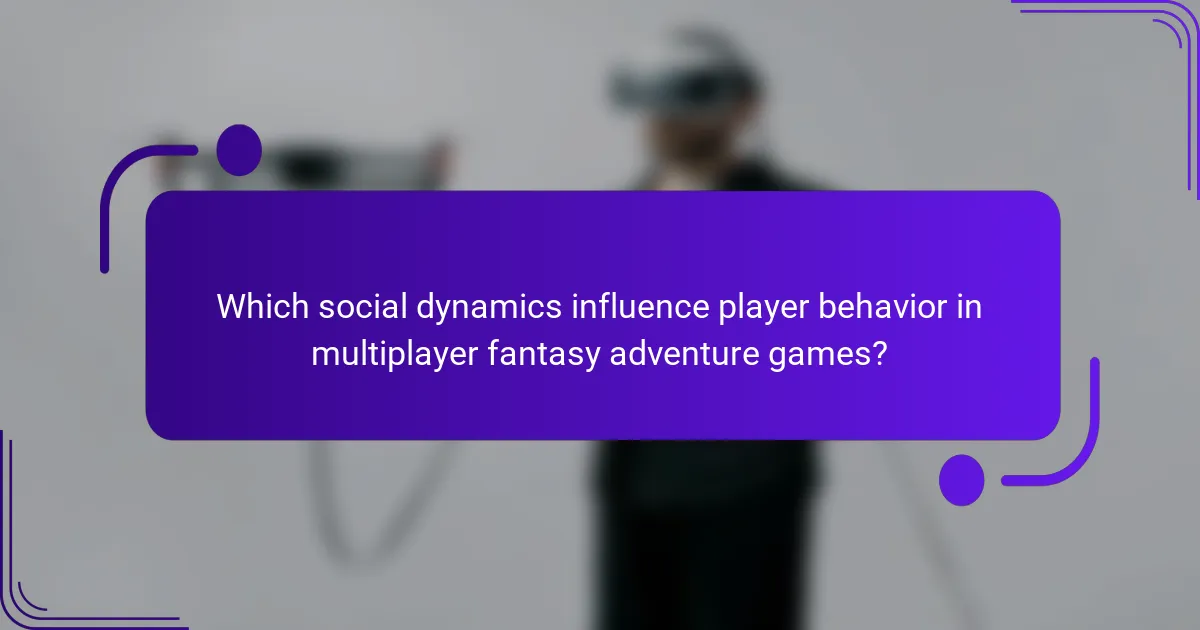
Which social dynamics influence player behavior in multiplayer fantasy adventure games?
Social dynamics significantly influence player behavior in multiplayer fantasy adventure games through collaborative and competitive interactions. Players often form alliances, share resources, and engage in social bonding, which enhances their gaming experience. The presence of guilds or teams fosters a sense of community, encouraging players to communicate and strategize together. Additionally, competitive elements, such as leaderboards and rankings, motivate players to improve their skills and outperform others. These dynamics create a rich social environment that shapes player engagement and satisfaction.
How does team collaboration impact gameplay experience?
Team collaboration significantly enhances gameplay experience by fostering communication, strategy development, and social bonds among players. Effective collaboration leads to improved team dynamics, allowing players to share resources and skills, which can result in better performance during challenges.
Multiplayer fantasy adventure games often incorporate features like voice chat, cooperative quests, and guild systems, which facilitate real-time interaction. These elements encourage players to strategize together, share insights, and build camaraderie. As a result, the gameplay becomes more immersive and enjoyable.
Moreover, collaborative gameplay can create unique in-game experiences, such as coordinated attacks or solving complex puzzles that require teamwork. This shared problem-solving aspect not only enriches the gameplay but also strengthens friendships and community ties among players.
In conclusion, team collaboration in multiplayer fantasy adventure games directly influences the overall enjoyment and engagement levels, making social interaction a critical component of the gaming experience.
What are the effects of competitive versus cooperative play on social interactions?
Competitive play fosters rivalry, enhancing motivation and engagement, while cooperative play promotes teamwork and social bonding. Both styles significantly influence social interactions in multiplayer fantasy adventure games. Competitive scenarios often lead to increased communication and strategic collaboration among players. Conversely, cooperative play encourages empathy and shared goals, creating a sense of community. Both types of interactions can shape player dynamics, affecting overall game enjoyment and social development.
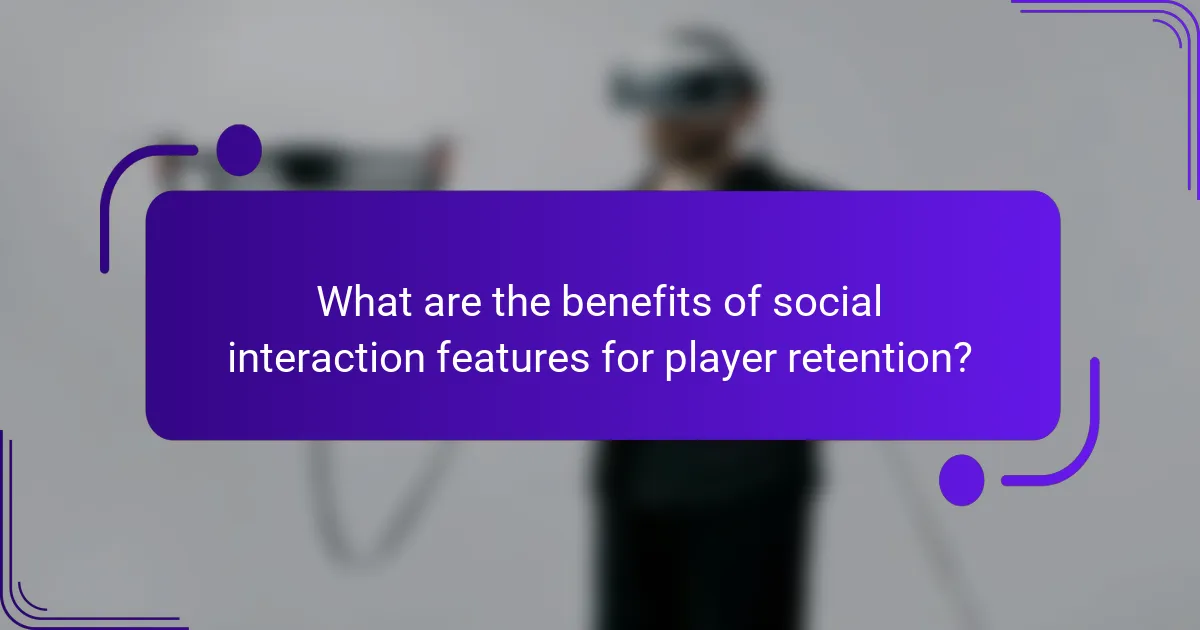
What are the benefits of social interaction features for player retention?
Social interaction features enhance player retention by fostering community engagement and emotional investment. These features create social bonds, encouraging players to return for collaborative gameplay and shared experiences.
Additionally, social features can increase competition, motivating players to improve their skills and stay active. Regular interactions through chat, guilds, or events keep the game dynamic and interesting.
Moreover, players often feel a sense of belonging, which can enhance their overall gaming experience. This emotional connection can lead to longer play sessions and increased loyalty to the game.
In summary, social interaction features in multiplayer fantasy adventure games significantly boost player retention through community building, competition, and emotional engagement.
How do social features contribute to community building?
Social interaction features significantly enhance community building in multiplayer fantasy adventure games. They foster connections among players, encouraging collaboration and social bonding. Features like guilds, chat systems, and cooperative quests create shared experiences, increasing player engagement and loyalty.
In-game events and leaderboards promote friendly competition, motivating players to interact and form lasting relationships. Additionally, user-generated content allows players to contribute creatively, further strengthening community ties. These elements collectively cultivate a vibrant, interactive environment that enhances the overall gaming experience.
What impact do friendships and alliances have on game longevity?
Friendships and alliances significantly enhance the longevity of multiplayer fantasy adventure games. They foster community engagement and encourage players to invest time in the game. Social connections lead to increased collaboration, shared experiences, and a sense of belonging, which motivates players to return regularly. As a result, games with robust social interaction features often see higher retention rates and prolonged player interest.
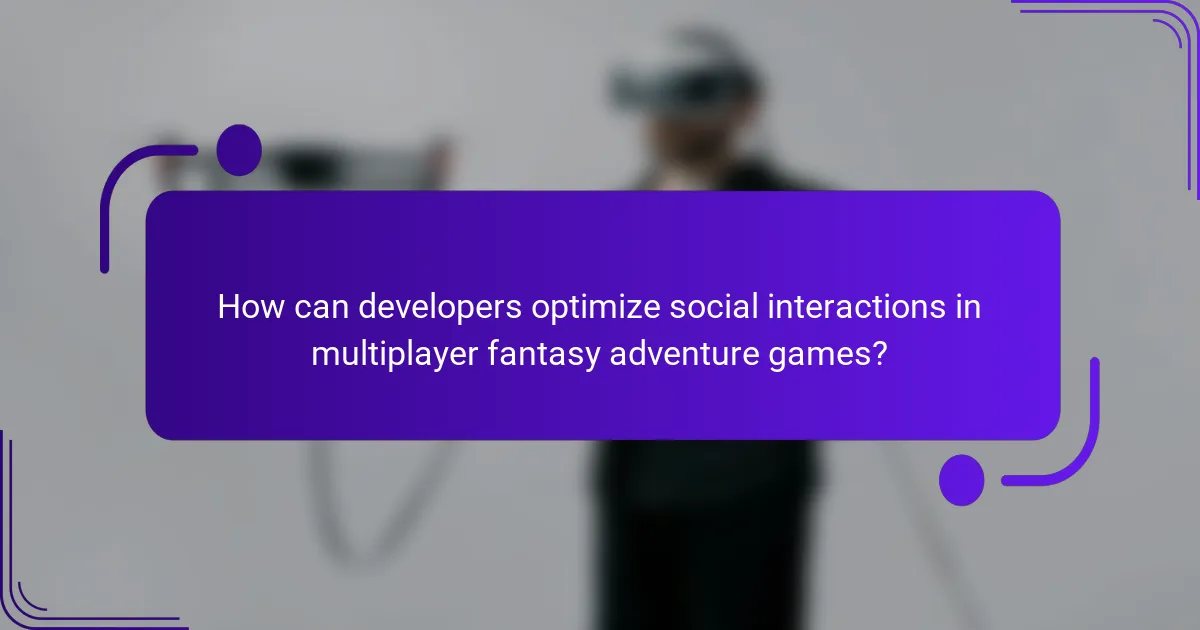
How can developers optimize social interactions in multiplayer fantasy adventure games?
Developers can optimize social interactions in multiplayer fantasy adventure games by implementing features that enhance communication and collaboration. Key strategies include integrating voice and text chat systems, creating guilds or clans for community building, and introducing cooperative quests that require teamwork.
Additionally, developers should consider user-friendly interfaces that facilitate easy interaction, such as emotes and gestures. Reward systems for social engagement can further encourage players to connect. Unique attributes like customizable avatars can enhance personal expression, fostering deeper connections among players.
As a result, these features not only improve user experience but also strengthen the game’s community, leading to increased player retention and satisfaction.
What best practices should be followed for designing effective communication systems?
Effective communication systems in multiplayer fantasy adventure games should prioritize clarity, engagement, and accessibility. Clear chat interfaces enhance player interaction, while voice communication fosters real-time collaboration. Incorporating customizable settings allows players to tailor their experience, accommodating diverse preferences. Additionally, integrating tutorial systems can guide new players through communication features, enhancing overall gameplay.
Which common mistakes should developers avoid in social feature implementation?
Developers should avoid common mistakes such as neglecting user privacy, overlooking scalability, and failing to test social features thoroughly. Prioritizing user experience is crucial for successful social interaction features in multiplayer fantasy adventure games.
Ignoring user feedback can lead to a disconnect between the game’s design and player expectations. Developers must ensure that social features enhance gameplay rather than detract from it.
Additionally, not considering the impact of social interactions on game balance can result in unfair advantages. Ensuring equitable access to social features is vital for maintaining a competitive environment.
Finally, underestimating the importance of moderation tools can allow toxic behavior to flourish, damaging the community. Implementing robust moderation is essential for fostering a positive gaming experience.
How can player feedback shape future social interaction features?
Player feedback can significantly influence future social interaction features by aligning game development with player preferences. Incorporating suggestions enhances engagement and fosters a community-driven environment.
Developers can analyze feedback to identify desired features such as improved chat systems, group quests, or customizable avatars. This process allows for the integration of unique attributes that resonate with the player base.
For instance, if players express a need for better collaboration tools, developers can prioritize features that facilitate teamwork, ultimately enhancing the gaming experience.
As a result, actively responding to player input not only shapes feature development but also strengthens the connection between the game and its community.

What are the emerging trends in social interaction features for 2025?
Emerging trends in social interaction features for multiplayer fantasy adventure games in 2025 include enhanced virtual reality experiences, AI-driven NPC interactions, and cross-platform play. These innovations aim to deepen player engagement and foster community building.
Developers are focusing on immersive environments that encourage collaboration. For instance, shared quests and dynamic events will require players to work together in real-time. This fosters a sense of camaraderie and enhances the overall gaming experience.
AI-driven interactions will create unique, responsive NPCs that adapt to player behavior. This will lead to more meaningful conversations and interactions, making the game world feel alive and personalized. Players will experience a richer narrative as NPCs react to their choices.
Cross-platform play will become standard, allowing players on different devices to interact seamlessly. This trend will break down barriers and expand the player base, promoting inclusivity and diverse social interactions within the game.
How is virtual reality reshaping social interactions in multiplayer games?
Virtual reality is significantly enhancing social interactions in multiplayer fantasy adventure games. Players experience immersive environments that foster real-time communication and collaboration.
VR technology enables shared spaces where players can engage in activities such as quests, crafting, and exploration together. This shared experience strengthens bonds and encourages teamwork, as players rely on each other’s skills to overcome challenges.
Moreover, unique attributes of VR, like body language and spatial presence, allow for more nuanced interactions compared to traditional gaming. Players can express emotions through gestures, enhancing social dynamics and making interactions feel more authentic.
As a result, virtual reality is reshaping multiplayer gaming by creating vibrant social ecosystems that prioritize connection and collaboration.
What innovations are being introduced to enhance player collaboration?
Innovations enhancing player collaboration in multiplayer fantasy adventure games include real-time communication tools, shared quests, and community-driven events. These features foster teamwork and engagement among players. Real-time voice and text chat enable seamless interaction. Shared quests allow players to tackle challenges together, enhancing the sense of camaraderie. Community-driven events create opportunities for players to collaborate on larger goals, strengthening the game’s social fabric. These innovations not only improve gameplay but also build lasting relationships within the gaming community.
How are cultural differences influencing social interaction designs in global gaming communities?
Cultural differences significantly shape social interaction designs in global gaming communities. Different cultures influence communication styles, collaboration preferences, and conflict resolution methods in multiplayer fantasy adventure games.
For instance, Western players may prefer direct communication, while Eastern players often value indirect approaches. This affects in-game chat systems and team dynamics. Additionally, cultural norms dictate how players perceive competition and cooperation, influencing game mechanics and community guidelines.
Understanding these cultural nuances allows developers to create more inclusive and engaging environments. Tailoring features like chat options, team formations, and reward systems can enhance player experiences across diverse backgrounds.
What strategies can players use to maximize their social experience in multiplayer fantasy adventure games?
Players can maximize their social experience in multiplayer fantasy adventure games by engaging with in-game communities, utilizing communication tools, and participating in cooperative missions. Building friendships enhances gameplay enjoyment and fosters collaboration.
Joining guilds or clans allows players to connect with like-minded individuals. These groups often provide support, resources, and opportunities for social events. Utilizing voice chat and messaging features facilitates real-time communication, making teamwork more effective and enjoyable.
Participating in events or challenges together can strengthen bonds and create memorable experiences. Players should also share their achievements on social media, inviting others to join their adventures, which can lead to new friendships and interactions.